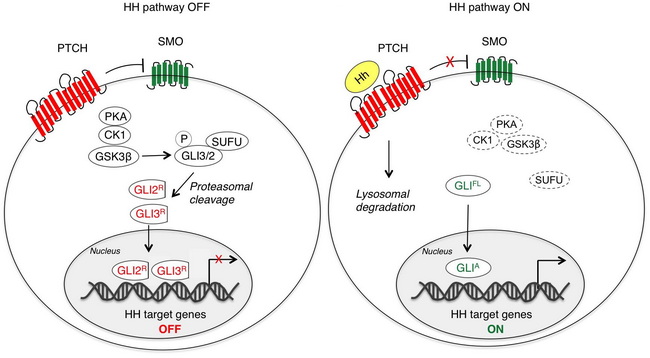Sonic Hedgehog Pathway


Comments:
Dysregulation of Sonic Hedgehog (SHH) pathway plays a key role in the pathogenesis of Gorlin-Goltz syndrome (Nevoid Basal Cell Carcinoma syndrome). The canonical SHH pathway primarily contains three components: a 12-domain transmembrane receptor (patched1, PTCH1), a seven-domain transmembrane receptor (Smoothened, SMO), and a GLIoma-associated oncogene homolog (GLI) family of transcription factors (GLI1, GLI2, and GLI3). SHH Pathway Off (Left Panel): In the absence of HH ligand, PTCH1 inhibits SMO resulting in proteasomal degradation of GLI2 and GLI3 and formation of repressor forms GLI3/2R which translocate to the nucleus and inhibit transcription of HH target genes. SHH Pathway On (Right Panel): In the presence of HH ligand, the repression of SMO by PTCH1 is relieved, allowing accumulation and activation of SMO. SMO promotes a signaling cascade that leads to translocation of activated forms of GLI (GLIA) into the nucleus, where they induce transcription of HH target genes.Image source: Pietrobono S, Gagliardi S & Stecca B. Non-canonical Hedgehog Signaling Pathway in Cancer: Activation of GLI Transcription Factors Beyond Smoothened. Frontiers in Genetics, June 2019; Vol. 10, Article 556; used under Creative Commons Attribution License, 4.0.



